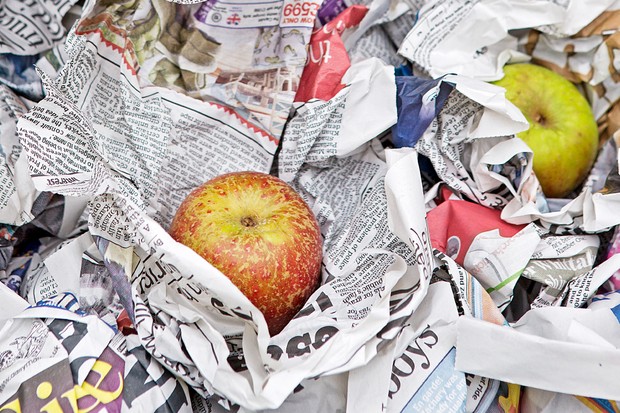
October is a mellow month with a fading, romantic and relaxed atmosphere to enjoy while putting the garden in order. There are still fruit and vegetables that need harvesting and storing to maximise the potential from this year’s hard work. Plus there are young plants to protect through winter as temperatures dip.
I always prepare in case the winter proves to be very cold – my small hands are not suitable for gloves so outdoor work isn’t always possible – and by the end of October my major work in the garden needs to be completed. I have to confess I don’t like housework, but I find giving the garden a once-over before winter a very rewarding job.
More gardening advice for autumn:
Sue’s 10 key jobs to get your garden autumn-ready
The mild warmth of mid-autumn presents gardeners with the perfect opportunity to enjoy a few restful days outside, gathering final harvests, storing and preserving this year’s bounty, and stealing a march on next year’s growing season.
Store apples

The cooking apples are now ready on the trees and are best picked in the morning when the fruit is still quite cool. I wrap them up loosely in newspaper so they’re not touching each other and store them in single layers in trays at a temperature of 3-7°. I also use any damaged ones immediately, making cider vinegar with the good parts.
Move seedlings
I have lots of self-seeded plants around the garden including wallflowers, forget-me-nots and verbascums. Most of them are in unwanted areas so I move them to where I want them to grow. This is a great way of saving money and reducing the garden’s environmental impact by using less resources.
Make leafmould

The falling of leaves marks the passing of the season. I love leaves; they are garden gold to be swept, kept and stored in bags behind the shed where they will turn into leafmould. One-year-old leafmould can be used as a mulch, while two-year-old leafmould can be used for growing seedlings.
Collect and dry flowers
Life is not all about harvesting food crops; selecting interesting seedheads and picking some hydrangeas to dry is a happy pastime. Pick mophead-type hydrangeas after the flowerhead has slightly changed colour and is firm to the touch.
Keep deadheading

There is still the regular task of deadheading to keep me busy. Cosmos and scabious continue to flower, particularly as I live in a mild, coastal location where frosts are quite rare, and some repeat-flowering roses can keep going until Christmas. Deadheading keeps colour in my borders, though I find roses often need reducing in size to withstand strong autumn winds.
Preserve green tomatoes
My indoor and outdoor tomatoes will not produce any more viable fruit and are ready for one final harvest. I like to get a big crop of green ones to make green tomato marmalade and pickled green tomatoes – both are winter favourites in our house.
Harvest potatoes

Collecting these is a priority, particularly with the potatoes in pots. When they are ready I tip the pot over with my feet. There is no digging and the potatoes are not damaged by a garden fork. They are easy to pick out and are fairly clean, too.
Protect pots and tools from the elements
My potting shed is open to the elements and it can get damp in the winter. With this in mind it’s important to collect any hastily abandoned seed packets and remove tools that may rust in the salty coastal air. I also collect any empty plastic pots, sort them by size and store them away from sunlight for use next year. I turn empty terracotta pots upside-down and put them in a sheltered spot outside to avoid frost damage.
Plant bulbs

The promise of spring beauty in a small, dried bulb is a marvel. Living as I do in Wales, planting daffodils is a must at this time of year. I have chosen Narcissus ‘Albus Plenus Odoratus’ which is white and strongly scented. I am cultivating a wild area within my lawn and white daffodils take centre-stage in early spring.
Pot on plants
A little earlier in the summer I collected and sowed seed from foxgloves, honesty and Ammi majus. I now have lots of free homegrown seedlings that are ready to be potted on and placed in a sheltered spot, ahead of being planted out to fill my borders next spring.
Make it work for you

Cut your autumn preparation to-do list down to size with Sue’s labour-saving tips and tool recommendations:
- Reduce work next spring by covering empty veg beds with a mulch of well-rotted manure – this keeps weeds at bay and improves the soil.
- Leave interesting seedheads in place for winter interest and to benefit wildlife. However, do cut back spent flowerheads on plants that are liable to self-seed out of control, such as toadflax, to reduce weeding next spring.
- Use a long-handled fruit collecting tool to gather fallen apples – it makes the task far less time-consuming.
- Get spring-flowering bulbs in place with a long-handled bulb planter. These make the job easier and create suitable holes for most spring-flowering bulbs.
- Collect fallen leaves with a pair of leaf grabbers. They are easy on the back and are much quieter and lighter to handle than a leaf blower.
- Prune with a long-reach tool. Invest in one that’s lightweight and has a quality cutting head. Choose one with a cut-and-hold function to stop prunings from falling on your head.
* This article was originally published here
Powered by Azon AutoSites
